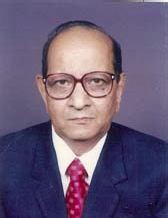Reminiscences
Professor Ramanath Keshavarao Katti, Professor Emeritus, IIT Bombay, India.
Interviewer: Madhira R. Madhav, Vice President (Asia), ISSMGE and Professor Emeritus, J.N.T. University, Hyderabad, India (Email:madhavmr@gmail.com)

Madhav: Prof. Katti, it is indeed very nice of you to give this interview. I thank you on behalf of ISSMGE, Prof. Kusakabe, Editor of the Bulletin and Dr. Choudhury, Managing Editor of June 2009 issue of the Bulletin. Can you share your beginnings and entry in to the nascent field of Geotechnical Engineering of which you are a pioneer especially in India?
Prof. Katti: I was born during the British Raj in Bijapur, Bombay presidency in 1928. My father was an overseer after his Diploma from Poona Engineering College in 1915. I completed my matriculation with high marks in Mathematics, Sciences and Sanskrit. I was keen to go for Arts and pursue my studies in Sanskrit. However, I heeded the advice of my parents to go for Science. I joined Fergusson College and completed my Inter-Science in First Class. I was admitted to Mechanical Engineering but changed over to Civil after the first year even though I was doing very well in Mechanical and Electrical Engineering subjects, because opportunities in Mechanical Engineering were then limited. I joined Kakrapara project, a part of Tapti River Valley Project in 1952. I was posted as a junior engineer at Mahuva, Navasari, in charge of Irrigation Colony. I encountered black cotton soil deposit for the first time and was told that the buildings being constructed would get lifted up when it gets wet instead of settling and in the process walls will crack and floors would be lifted up. When the foundation was cast for the first building and water sprinkled for curing the base course got lifted up and hence cracked. Mr. Nayegamwala, Head of the department at Poona Engineering College, posted as executive engineer on the project told me that there was no solution to construct stable structures on black cotton soils. My elder brother was working for his Ph. D. and I realised that some research is needed to solve this problem. I got admission to Iowa State College, Ames, Iowa USA, soon after to pursue graduate studies under Exchange Visitor Programme. Thus I switched from professional career to academics.
I left India in 1953 by boat and reached Ames after 35 days of travel. Prof. Davidson, my guide, asked me to meet Prof. Stewart, the Head of the Department, to finalise my course programme for the fall session. He put me in structural engineering stream. However, it became necessary for me to pursue my graduate studies in Highway Engineering or Soil Engineering as an assistantship was available only in a Highway Research Board sponsored research. I took Highway Engineering as a major and Soil Engineering and Earth Sciences as minors. The topic for my Masters dissertation was Soil Stabilization with Bituminous Materials. For this purpose I had to take courses in organic chemistry, physical chemistry, electro chemistry, soil genesis and classification, clay mineralogy, in addition to my engineering subjects. These subjects helped me in providing a strong science based research programme for Ph. D. thesis in soil engineering and for solving problems due to expansive soil on scientific basis. They helped me in analysing large organic cations with silica surfaces in the form of thin films, free energy interaction between silica surfaces and water and silica surfaces and large organic chains. At certain conditions thin films of large organic chains can replace thin water films. This was unconventional behaviour but scientifically acceptable. Thus in dealing with unconventional behaviour soil one should consider soil particles as matter and apply thermodynamics, physical chemistry and earth science principles to solve stress – deformation problems. My outlook towards solving unconventional behaviour of soil water system or stabilized soil changed forever. I was awarded National Scholastic Honour. Several papers based on my work were accepted for presentation and published in HRB journal.
Madhav: Could you apply your research on expansive soils in US while working for your Ph.D.?
Prof. Katti: Dr. Davidson got a large consulting project to develop methods to utilize fly ash for stabilization of road bases on various types of soil deposits in Detroit Edison power plant area. 700,000 tonnes of fly ash was being produced per year as a waste product. One dollar per tonne was being spent for disposal. The project involved development of a method to stabilize soils for road building and construction methods including equipment for field construction. The studies were to be conducted both in the laboratory and in the field. The entire work was to be completed in 55 days. The temperature in the field could go below 55o F and the mix would not harden. Many of my colleagues refused to work on the project because of time constraint but I offered to work on it and the project was completed on time. Detroit Edison Co. started selling the fly ash at factory outlet for 1.5 $ per tonne. I had to sacrifice a term but it paid off in my future life as I could handle any difficult problem. >> Read more




































